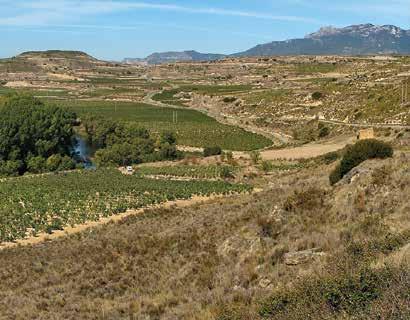
3 minute read
Spain: A Study in Contrasts
By Michael Palij MW
Spain is a study in contrasts: its culture a mix of old-school Catholic conservatism and forward-thinking liberalism, its cuisine a blend of hearty traditional fare and innovative modernism, and its landscape and climate an assemblage of arid sun-baked plateaus and sea-cooled coasts. It’s unsurprising to discover that the diversity of Spanish wine captures this world of contradictions in a microcosm of elaborate diversity.
Advertisement
For many, Spain’s vinous calling card is Tempranillo, a shape-shifting grape that lends itself as well to brightfruited, supple quaffing wines as it does to complex, age-worthy cuvées. The region most strongly associated with this variety in the minds of most wine lovers is Rioja, an eclectic patchwork of terroirs that ranges from the Mediterranean warmth of Rioja Orientale to the more temperate Atlantic-influenced slopes of Riojas
Alavesa and Alta. Sprinkle in a dash of other grapes to add complexity to the blend – Graciano for brightness, Garnacha for warmth and Mazuelo (aka Carignan) for richness – and maturation regimes that range from the youthful unoaked joven styles, through crianzas and reservas to the long-aged gran reservas, and you have a recipe for broad-ranging appeal.
Tempranillo is the cornerstone of red wines from other regions in northern Spain, too, even if it does travel under an alias in both Toro (Tinta de Toro) and Ribera del Duero (Tinto Fino and Tinto del Pais). In the latter, the grape is often seasoned with so-called international varieties, particularly Cabernet Sauvignon, leading to the creation of dark-fruited, firmly structured, long-lived wines. These international varieties – and others – are also widely planted alongside Tempranillo and Garnacha in Navarra, alongside a range of white grapes, notably some very fine Chardonnays and, perhaps surprisingly, floral Muscat grapes that make luscious dessert wines. This region, arguably the Swiss Army knife of Spanish DOCs in terms of its versatility, is also renowned for making some of the country’s best – and most refreshing – rosados.
Garnacha – Southern France’s Grenache – is very much at home across a broad swathe of Spanish terroirs, especially in the northwest of the country. The most famous of these wines comes from the arid badlands of Priorat, where slatey llicorella soils force roots to dig deep. Garnacha and Mazuelo are vinified (usually separately, but sometimes blended with each other or with international varieties) in these Catalan hills to create heady, tannic red wines with surprising levels of freshness. Meanwhile, in the craggy sierras west of Madrid, winemakers in the Sierra de Gredos are overturning expectations of Garnacha’s typicity by using it to make bright, aromatic reds that are surprisingly light on their feet for a grape usually renowned for its heft.
You get similar levels of crunch and perfume from reds made from Mencía in Bierzo, a region bathed in Atlantic winds, and the red wines of Ribeira Sacra almost defy description in their idiosyncratic wildness. Oceanic influence also has its part to play in the peppery typicity of Tenerife’s Listán Negro – although, here, volcanic soils and altitude also help to determine style.
But Spain is not just about red wines, even though these tend to be the most visible fruits of the Iberian vineyards. Those volcanic islands produce salty, smoky wines made from Listan Blanco, while the rain-swept Atlantic region of Rías Baixas is the source of zesty Albariños. Slightly further inland – but still strongly influenced by the ocean – you’ll find richly textured, aromatically restrained Godello in Ribeira Sacra and Valdeorras. This relatively unknown grape is a rising star in the Iberian firmament and, arguably, gives Burgundy a run for its money when on form.
Over on the northwestern side of the country, in Catalonia, diversity is king. Varieties that have long grown here are planted alongside newer international arrivals such as Chardonnay and Riesling. Rioja has its own suite of white wines, ranging in style from crisp neutrality to richly oaked traditional bottlings with layers of oxidative complexity. Viura is the main grape here, aided and abetted by the more floral Malvasia, heady Tempranillo Blanco and a range of other grapes.
That Viura – under its alias of Macabeu – is a critical component of the blend in Spain’s own take on traditional method sparkling wine, Cava, alongside Xarel·lo and Parellada. Quality is very much on the up, and these sparkling wines are increasingly sought after by aficionados of fine sparkling wines for their distinctive character.
This is far from being an exhaustive list of Spain’s vinous treasures – there’s simply not enough space here to delve much deeper – but it would be remiss not to mention Jerez, a region that embodies diversity with a portfolio of styles ranging from bone-dry wines aged under flor to the layered complexity of oxidatively aged olorosos, palo cortados and amontillados and the unctuous sweetness of wines based on Moscatel and Pedro Ximènez grapes. And if you fancy a change from wine, don’t forget that Spain also offers vermouths and gins – just right for a pre-prandial palate sharpener – and world-class brandies too.











